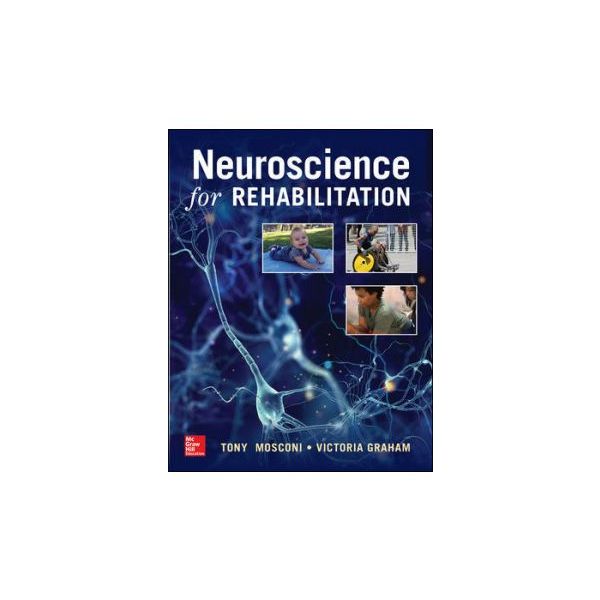NEUROSCIENCE FOR REHABILITATION
The first neuroanatomy text written specifically for physical therapy students
Written by recognized experts in human nervous system development, Neuroanatomy for Rehabilitation provides physical therapy students with a thorough understanding of the anatomical localization of brain function. Approximately 200 line illustrations and photographs teach students how to accurately interpret the wealth of new human brain images now available.
The text opens with an informative section that discusses the structural and functional organization of the nervous system and includes coverage of functional neuroanatomy and response to injury. This is followed by sections covering:
• Vascular Supply of the Central Nervous System (arterial supply, venous drainage, response to injury)
• Cellular Organization of the Nervous System
• Development of the Central Nervous System
• Functional Neuroanatomy by Ascending Region
• The Brainstem, Cranial Nerves and Visual Pathways
• The Cerebellum and Basal Ganglia
• Diencephalon
• The Cortex
Each section opens with a case study and an overview of key concepts, and concludes with case discussion and review questions. No other text provides physical therapy students and instructors with such relevant, authoritative, and well-written material designed to enhance understanding of the human nervous system as Neuroanatomy for Rehabilitation.
| Author | MOSCINI |
|---|---|
| Table Of Content | Neuroanatomy for Physical Therapists Draft Table of Contents I. Introduction to the Nervous System A. Neuronal Cytology B. Neuronal Signaling (excitability, membrane, action potential, AP propagation and fiber diameter, synapses) C. Functional Organization of the NS 1. PNS (nerve roots, spinal Nn, plexuses, peripheral nerves, sensory endings, motor endplate, Wallerian degeneration, sprouting/regeneration, demyelinating diseases) 2. CNS a. Support cells b. Pathways, tracts, fasciculi, funiculi, columns, lemnisci c. Spinal cord (topology, internal anatomy) d. Brainstem (topology, internal anatomy) e. Diencephalon (topology, internal anatomy) f. Forebrain (topology, internal anatomy) g. Cerebral cortex topography and functional specialization 3. ANS (sympathetics, parasympathetics, pre- and postganglionics, autonomic ganglia) II. Blood and CSF Circulation A. Carotid and Vertebral Aa (circle of Willis) B. Spinal Cord and Brainstem Blood Supply C. Forebrain Blood Supply D. Meninges And Brain Coverings E. CSF Production And Circulation (hydrocephalus) III. Development of the CNS A. Embryonic Brain (dysraphic and myeloschistic defects) B. Juvenile Brain (CP, MS) C. Mature Brain (ALS) D. Aged Brain (Alzheimer’s, dementia, Parkinson’s) E. Critical Periods and Neuroplasticity IV. Functional Neuroanatomy by Region A. Spinal Cord 1. PNS-CNS junction 2. Long ascending somatosensory pathways a. Dorsal column-medial lemniscus b. Anterolateral system (Spinothalamic tract) 3. Long descending somatic motor pathways a. Corticospinal tract b. UMN-LMN c. Reflexes d. Spasticity 4. Brown-Séquard syndrome B. Brainstem 1. Long pathways a. DC-ML b. ALS c. CST d. Corticobulbar (Corticonuclear) Tract (unilateral lesion, facial paresis) 2. Medulla a. CNn nuclei (XII, X, IX, VIII, VII) and peripheral nerves b. Lateral medullary syndrome c. Medial medullary syndrome – inferior alternating hemiplegia 3. Pons a. CNn nuclei (VI, V) and peripheral nerves b. Locked-in syndrome c. Middle alternating hemiplegia d. Acoustic neuroma 4. Midbrain a. CNn nuclei (IV, III) and peripheral nerves b. Weber’s syndrome – superior alternating hemiplegia 5. Diencephalon a. Thalamus b. Internal capsule c. Thalamic and capsular lesions C. Cerebellum 1. Topology, internal anatomy 2. Cerebellar cortex circuitry 3. Afferent input 4. Efferent output 5. Motor learning 6. Balance 7. Ataxia, intention tremor, ipsilateral deficits D. Forebrain 1. Basal Ganglia (Basal Nuclei) a. Component nuclei b. Circuitry c. Parkinson’s disease d. Huntington’s chorea e. Contralateral hemiballismus 2. Cerebrum a. Cerebral cortex architectonics (6 layers, input and output layers, regional functional differentiation) b. Fiber systems (superior longitudinal fasciculus, arcuate fasciculus, corpus callosum, anterior commissure, corona radiata, optic radiations) c. Gyri and sulci 1) Topology 2) Functional differentiation d. Deficits – TBI, CVA V. Vestibular System A. Peripheral Anatomy B. Brainstem Anatomy C. Circuitry (local, ascending, and descending pathways, MLF) D. Vestibulo-ocular Reflexes E. Lesions (vertigo, nystagmus) F. Therapeutic Manipulation VI. Visual System A. Anatomy (eye through visual cortex) and connectivity B. Sensory Function 1. Construction of the visual field 2. Deficits (blindness, hemianopsia, quadrantopia, complete blindness, pituitary tumor, macular degeneration/sparing) C. Motor Control of the Visual System 1. Eye movements (CN III palsy, CN IV palsy, CN VI lateral rectus and lateral gaze palsies, internuclear ophthalmoplegia) 2. Eye movement reflexes (VOR, oculocephalic reflex, doll’s eye sign) 3. Pupillary reflexes D. Vestibulo-optic Interactions – functional and therapeutic implications VII. Reticular Formation A. Anatomy and Connectivity B. Neurotransmitters C. Reticular Activating System 1. Consciousness, arousal, sleep-wake 2. Vital functions 3. Descending pain modulation 4. Lesions (infratentorial herniation, decerebrate/decorticate posturing) 5. Therapeutic manipulation VIII. Limbic System A. Anatomy and Connectivity (hippocampal formation, Papez circuit) B. Learning, Memory, Emotions C. Olfaction and the Limbic System C. Lesions (temporal lobe epilepsy, anterograde amnesia, Alzheimer’s, dementia, Korsakoff syndrome, Kluver-Bucy) IX. Hypothalamus and the ANS A. Anatomy and Connectivity of the Hypothalamus B. Central Autonomic Structures 1. Sympathetic (spinal cord lateral horn, preganglionic neurons) 2. Parasympathetic (cranial and sacral preganglionic neurons) C. Peripheral Autonomics 1. Sympathetic (ganglia, postganglionics) 2. Parasympathetic (ganglia, postganglionics) D. Lesions (hypothalamic syndrome, complex regional pain syndrome) X. Pain A. Peripheral nociceptors – Primary and secondary hyperalgesia B. Spinal cord dorsal horn (substantia gelatinosa) and spinothalamic tract C. Reticular formation, PAG, and the hypothalamus – Descending pain modulation D. Chronic Pain E. Maladaptive cortical remapping Appendix 1 Neuroimaging (assessing images and diagnosing lesion) Appendix 2 The complete neurological exam Atlas |
| Publish Date | 16 Oct 2017 |





